Menu
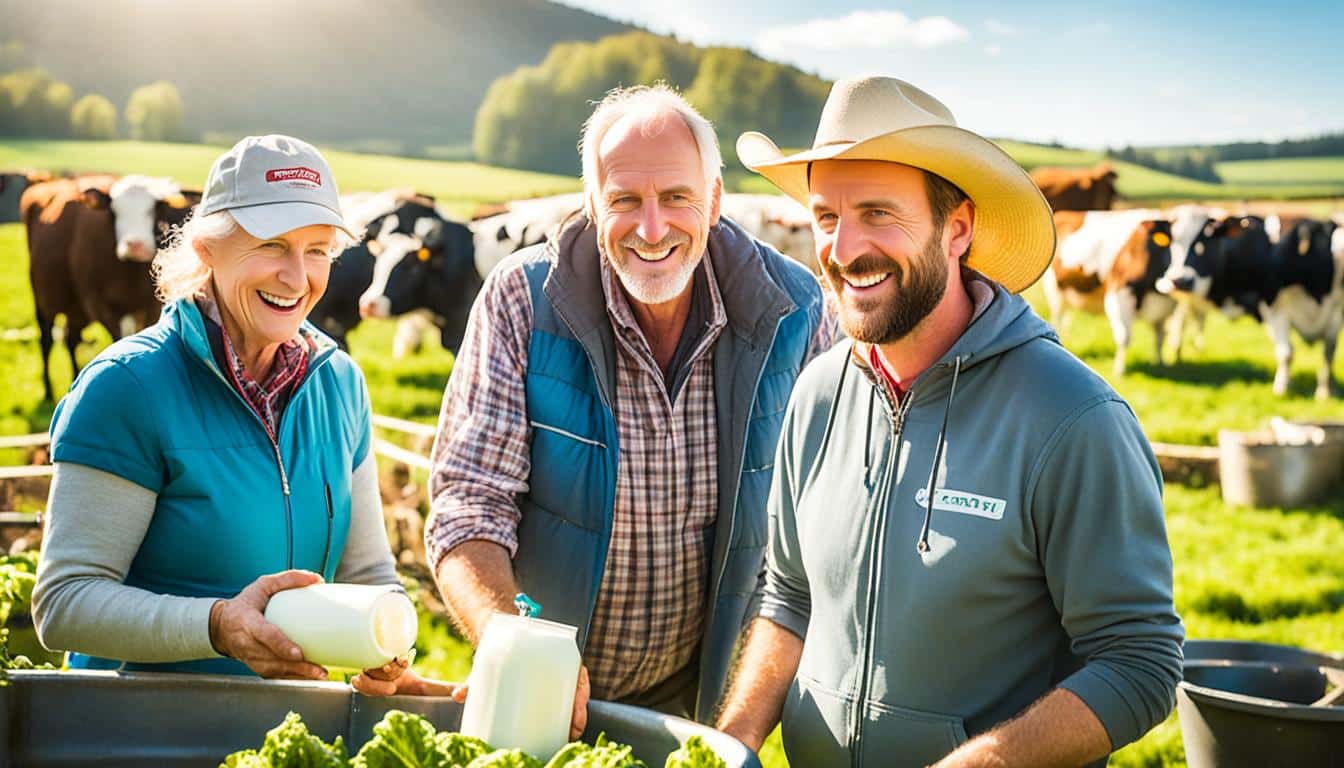
Did you know people spend seven times more on fun than food? This shows how farmers can earn more by offering fun farm tours. They can bridge the gap between city and country, giving people hands-on farm activities that are fun and educational.
A great farm tour makes the world of farming and local food come alive. It should highlight things that may seem ordinary to farmers but are really cool to others. Planning a good route is key. It keeps visitors safe and shows off the farm’s best parts.
Having clean toilets and easy-to-find parking is a must for visitors. These details are really important for people to enjoy the tour overall.
Themed tours are a fun way to show off different farm activities, like growing crops or raising animals. They can also be tailored for school groups to boost learning. Self-guided tours with clear signs are great too. They need less staff and keep the experience top-notch.
By focusing on these basics, farmers can offer tours that are fun and informative. This not only brings in more money but also deepens the farm’s ties with the community and further afield.
Agritourism is all about inviting people to experience farming first-hand. This can range from buying fresh produce at stands to exploring a fun corn maze. It connects the public with the real, day-to-day life of farming.
Agritourism combines the fun of tourism with the heart of agriculture. It invites people to join in activities like picking their own fruit, staying at a working farm, or taking part in season events. This mix gives a real taste of countryside living, far from the city.
Its main goal is to teach through enjoyable farm visits. These visits help people understand and support sustainable farming. In this way, agritourism plays a key part in connecting the public with the land and its processes.
For those in farming, agritourism can boost their income and educate visitors. It does this by creating jobs for the locals, from guides to hospitality staff. It also helps small businesses and crafts by increasing their sales.
Moreover, it encourages sustainable farming, which is good for the environment. This way, agritourism helps farmers, the community, and the earth.
As for visitors, agritourism is a mix of fun and learning. Families can have a great time on farms, learning about where their food comes from. They can also stay overnight on farms to see farming practices hands-on. This not only makes their trip enjoyable but also educative, benefiting both visitors and the farmers.
“Agritourism promotes the preservation of local culture, traditions, and ideas, encouraging the exchange of cultural experiences between tourists and locals.”
When planning a farm tour, you need to think hard about what will interest your guests. Pick spots and activities that stand out. Make sure they’re both fascinating and safe. This way, visitors will have a great time.
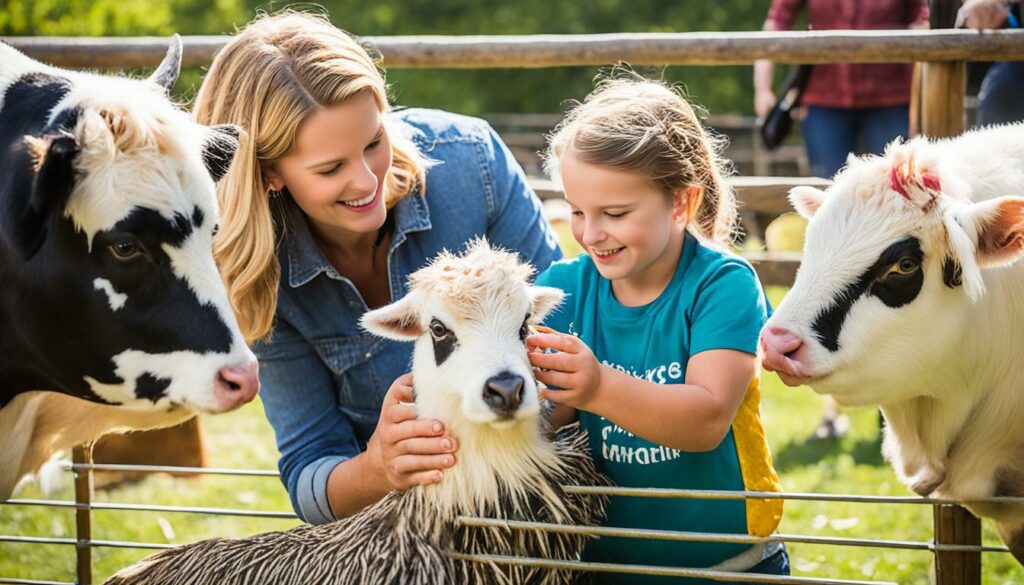
Organic farms are a perfect place to explore. Gardens, orchards, and animal areas are key. They not only look good but teach visitors many key things. Point out places that use special farming or water-saving ways. Think about adding fun things for visitors to do, like picking fruit.
The experts from the Oregon and Washington State Academies know their stuff. Their tours visited cool places like Pacific Natural Foods and a hazelnut orchard. These stops gave visitors new and interesting info.
Though you want to show off your farm’s best, keeping visitors safe is vital. Avoid places with big machines, chemicals, or wild animals. It’s smart to plan to reduce risks, have an emergency plan, and the right insurance.
Farms like Appalachian Grown Farms know that safe tours make people happy. Safe and well-arranged tours can do wonders. They bring in new visitors and make the tour an enjoyable experience for everyone.
Making farm tours fun and safe is our top priority. We put in place tough safety rules and make sure visitors have everything they need. This way, everyone can enjoy learning and getting hands-on experience in farming. It’s not just a visit; it’s an adventure for all ages.
It’s vital to have safety in mind at all times. We start by marking safe parking spots, especially for families. Good, clean toilets are a must, too. We plan our activities carefully, avoiding any risky spots. And, our team is trained to keep everyone safe on the tour.
We aim to make farm workshops both fun and secure. Visitors can dive into farm life safely. We carefully check the risks and keep an eye on everyone, especially around animals. This ensures a fun, but also a safe, learning experience.
A well-planned farm tour ensures everyone has a great time safely. It makes people want to come back and tell their friends. Family-friendly fun makes sure every guest enjoys and learns about farm life.
For engaging farm tours and great agritourism experiences, restrooms and parking are vital. You need to know if your current setup can handle the visitors. Consider if you need to add portable toilets, which are often rented.
Good parking areas are also very important. They should be clearly marked and have a flat, safe surface. This makes it easier for guests to park and leave. For big groups or buses, you must plan even more. You need to check if there’s enough space and if large vehicles can move around easily. Also, think about how the ground might change with the seasons.
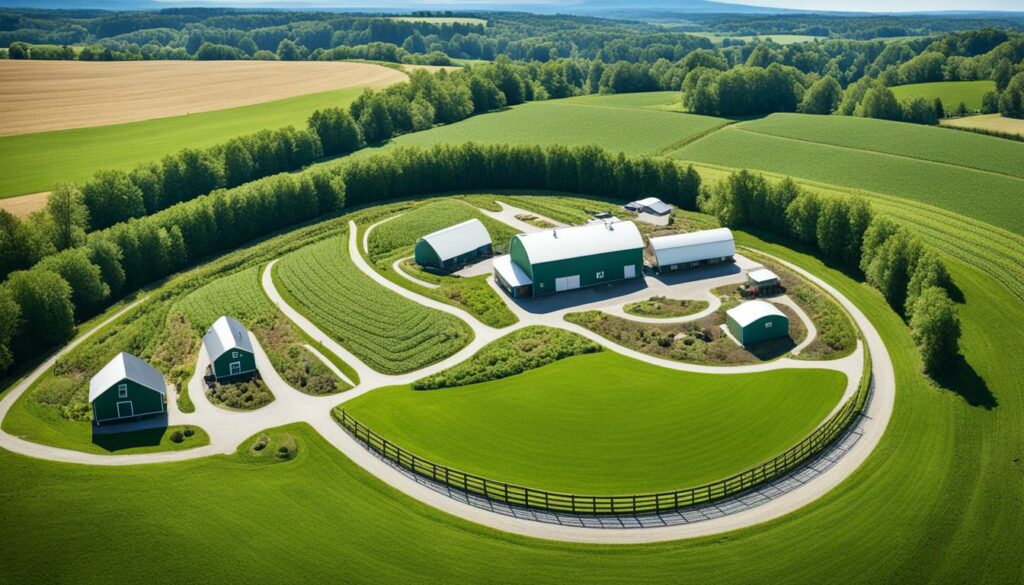
Getting logistical details right is key to great agritourism experiences. When you plan well, visitors notice and enjoy their visit more. This shows the farm cares about them. Good restrooms and parking also make themed tours better. They may include soil care, caring for orchards, and using clean energy. These topics make the visit both fun and educational.
Themed tours make the farm visit much better. They tell stories about eco-friendly agriculture and let people do farm jobs. These tours can look at different topics like fixing soil, looking after fruit trees, using clean energy, raising animals, or growing crops. They fit with what’s happening on the farm to show visitors farm life in an exciting way.
These tours are great for many people. This includes kids wanting to learn and work on the farm, and city folk wanting to relax in the countryside. Self-guided tours with good signs and maps mean visitors can go at their own speed, getting a personal tour.
Themed tours also help financially. Working out costs and sales helps keep things in check. Easy booking, using phones, email, or sites like Eventbrite, makes it simple for people to sign up and know what to expect.
“Incorporating themed tours not only attracts a diverse audience but also showcases the rich tapestry of sustainable farming practices,” notes a recent industry study.
Good staff and making the tours interesting are key. Tours should touch people’s senses to make the visit memorable. Safety, through insurance and risk management, is vital for tour success.
For a complete view, look at this table. It shows the main points and advantages of themed tours:
| Theme | Topics Covered | Visitor Engagement | Benefits |
|---|---|---|---|
| Orchard Care | Pruning, Pest Management, Harvesting Techniques | High | Educational, Hands-on Activities |
| Renewable Energy | Solar Panels, Wind Energy, Sustainable Practices | Moderate | Inspires Sustainable Living, Technological Insights |
| Animal Husbandry | Feeding, Breeding, Care Techniques | Very High | Interactive, Family-friendly |
| Crop Production | Planting, Irrigation, Harvesting | High | Participatory, Educational |
Tailoring tours can turn a farm visit into a story about green agriculture and hands-on work. This makes every visit unforgettable and educational.
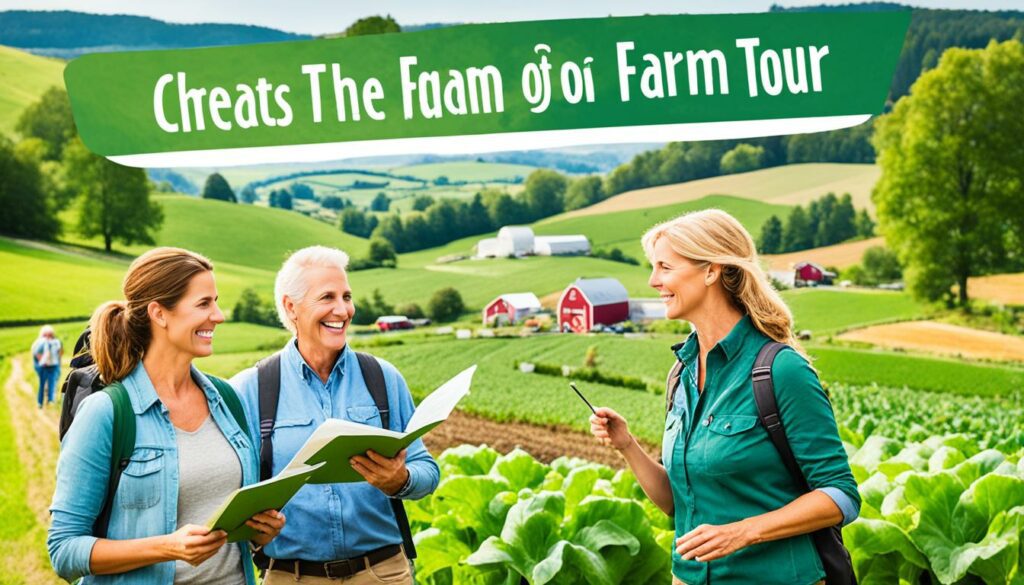
Self-guided tours give freedom to both farm owners and guests. They offer a chance to learn about the farm’s different parts. To make these tours great, clear signs and good maps are key.
In self-guided tours, clear signs are very important. Signs should tell guests where to find interesting things, teach them, and keep them safe. Fun pictures on signs can help, especially for educational farm visits. Signs must be tough and easy to see, so everyone can read them well.
A detailed map is a must for a good self-guided tour. Maps should show places like gardens, orchards, and where the animals are on organic farm explorations. It’s also great to show the best paths, rest spots, and places visitors shouldn’t go. Adding a game like a scavenger hunt on the map can make the visit even better.
| Type of Tour | Duration | Key Features |
|---|---|---|
| Guided Tour | 1 hour | Greenhouses, compost rows, production fields, livestock pastures, yurts, solar energy installations |
| Self-Guided Tour | Flexible | Prospective student audio walking tour, interactive scavenger hunts |
Self-guided tours are ideal for educational farm visits. They let people explore at their own pace. But, it’s vital to have good signs and maps so everyone can enjoy and learn safely on the organic farm explorations.
Designing farm tours for school kids needs careful thought. This is because students’ needs and tastes vary with their ages. A well-planned tour makes learning fun and interesting for all. It ensures everyone has a good time.
Tailoring farm visits to different age groups is key. For younger kids, keep it simple and fun. Use stories and hands-on activities to engage them. Things like meeting animals and planting can be exciting for them.
Teenagers can delve into more complex farm topics. This might include sustainable farming or agricultural science. Linking these talks to what they’re learning in school helps make it all more meaningful.
Hands-on tasks are vital for any farm visit. They not only enhance learning but also make memories. Kids can plant seeds or feed animals to learn about farming first-hand.
LEAF Education Specialists are great at designing such activities. They make sure they fit with what students are studying. Plus, they ensure tours happen in safe places.
Customised visits can meet specific educational needs. They can help every student learn better. Also, they offer training to teachers. This helps bring the importance of farming to daily lessons.
| Grade Level | Activity Ideas |
|---|---|
| Elementary | Visits to local farms, fruit picking, scavenger hunts. |
| Middle School | Science camps, community garden projects, thematic farm tours. |
| High School | Business studies workshops, visits to food distribution centers, charitable activities. |
Working with local experts can make a farm visit more enriching. Such as, sessions with the fire department can teach safety. Or, chefs can talk about food. This makes the trip educational in many ways.
Running farm tours well requires focus and a detailed plan. A smart budget means you can keep the tours going and make them a hit with visitors.
First, you need to know all the costs of running the tours. This includes what you pay people, keeping the place up, getting the word out, and more. Doing a break-even check helps you see if it all makes financial sense.
“Charging for tours may be less risky than offering free or low-cost tours. It’s recommended to consider income and expenses carefully and use a break-even analysis to determine profitability.”
Using a partial budget can show how changes, like new crops, impact on the budget directly.
Once you know the costs, it’s time to set a good price. It should cover costs and show the value of what visitors get, like fun tours and cooking events. This way, the tours attract people and make money for the farm.
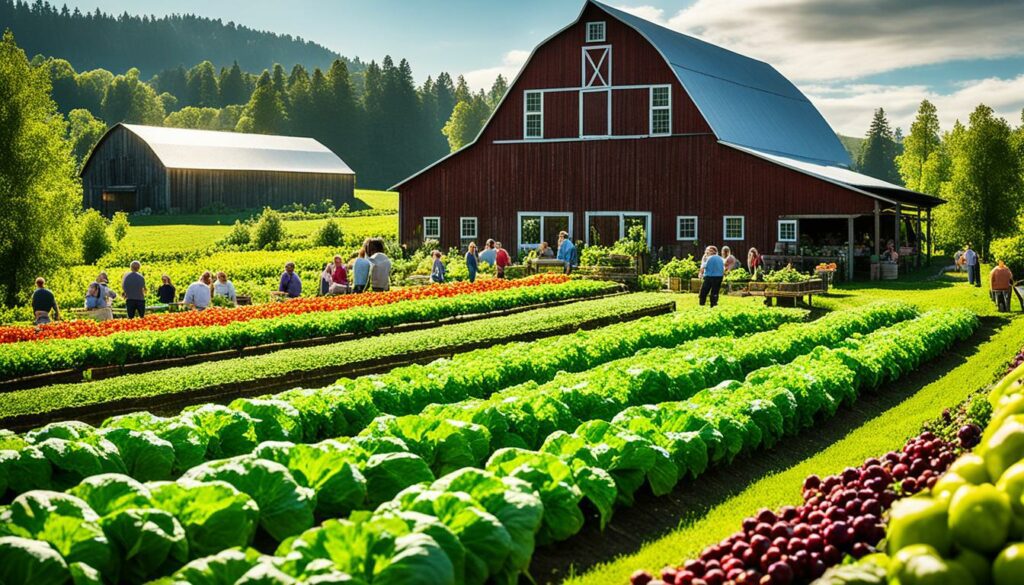
Think about how much money the tours will make, plus extra cash from selling things or offering more services. This approach keeps the prices fair and helps the farm make more money.
“For self-guided tours, having good signage, well-marked routes, and maps are essential components for success.”
To wrap up, making farm tours that work well financially is about knowing the costs and charging a fair price. This way, farms can offer awesome experiences and stay financially sound.
Setting up a good tour sign-up system is key to making farm tours smooth. Using a strong system, be it through calling, emailing, or tools like Eventbrite, means everyone has an easy time.
It’s crucial to manage how many people can join each tour. By setting clear rules on how many can come, you can avoid too many people showing up. This makes the tour more special, particularly with activities where guests get their hands dirty.
Selling tickets in advance can make signing up simpler. It helps the farm get ready for visitors and manage their resources better. This approach also stops people from booking and not showing up, securing the farm’s income and plans.
A well-organised system with these features can make your tours more attractive. Adding tech like QR codes and automated messages can make the process even better. This way, everyone knows what to expect before they arrive.
Below is a table that shows the upsides and downsides of various ways to sign up for tours:
| Method | Pros | Cons |
|---|---|---|
| Phone Bookings | Personal touch, immediate confirmation | Time-consuming, limited to working hours |
| Email Registrations | Documented, flexible timing | Potential delays in response, less personal |
| Online Platforms | Automated, 24/7 accessibility, streamlined payments | Requires internet access, may incur fees |
Customer service is key to a great farm tour, making it fun for families and teaching about sustainable farming. Having a friendly and smart team is important. They make every visit great, so people want to come back.
Training is vital for great customer service. Staff should know all about the farm, and how it grows things and uses energy. They also need to be friendly and easy to talk to. This makes everyone’s visit better.
Connecting with visitors makes farm tours fun and educational. Staff can let guests touch fresh produce and see how the farm works. They should also show them the best spots for photos. This makes the visit memorable.
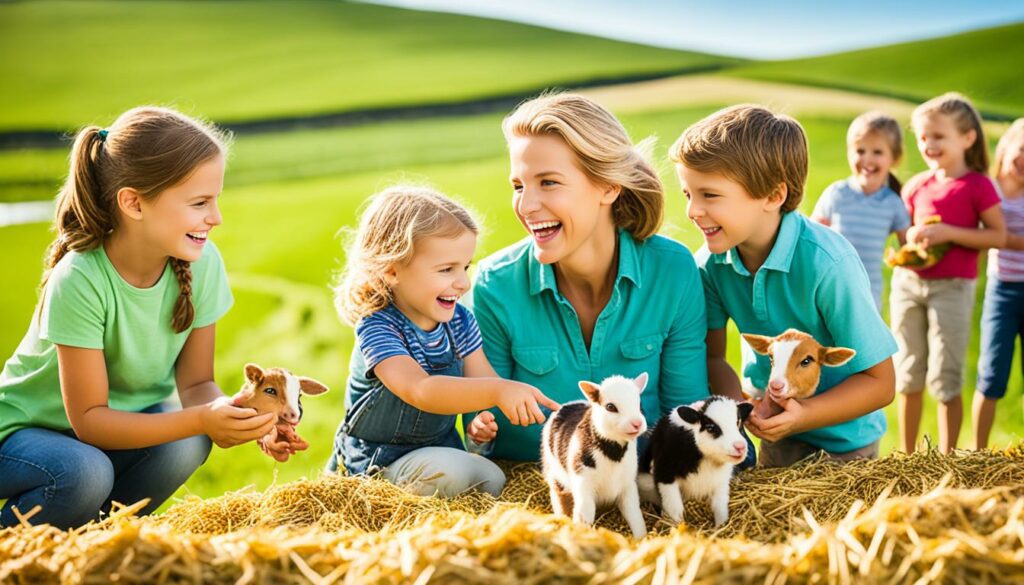
Making visitors feel welcome makes them want to come again and tell their friends. Feedback from visitors helps the farm get better at what it does. Mystery shoppers give a true look at the service being offered.
| Service Aspect | Impact | Improvement Strategy |
|---|---|---|
| Staff Training | Higher visitor satisfaction and repeat visits | Regular training sessions and incentives |
| Visitor Engagement | Enhanced visitor experience and positive reviews | Interactive activities and photo opportunities |
| Feedback Analysis | Service improvement and increased visitor numbers | Implementing a feedback loop and mystery shopper evaluations |
To sum up, great customer service makes farm tours not just good but great. It’s about creating memorable experiences that promote eco-friendly farming. By training the team well, making visitors part of the adventure, and listening to feedback, the farm will stay popular.
Effective safety and risk management are key in agritourism experiences. It’s vital to have updated liability insurance that covers all activities. This includes using proper signage, closely supervising activities, and dealing with any hazards right away.
Following local rules is crucial, especially for animals and food safety. For hands-on farming workshops, careful planning to handle safety matters is a must. This helps ensure everyone’s well-being.
It’s also essential to consider ADA compliance for access. A safe and warm welcome makes farm visits enjoyable for all. This careful safety planning builds trust and keeps guests happy, promoting sustainable farm tourism.
A solid marketing plan is key to drawing in visitors. It makes farm tours more visible and appealing. Using digital channels, like social media, is a great way to connect with more people. By sharing eye-catching content, you can attract visitors and highlight unique experiences on your farm.
Facebook, Instagram, and Pinterest are great for forming a community for your farm. Almost all adults in the U.S. use the internet, with most on social media. These platforms let you connect with visitors, showing off the daily farm life and announcing special events.
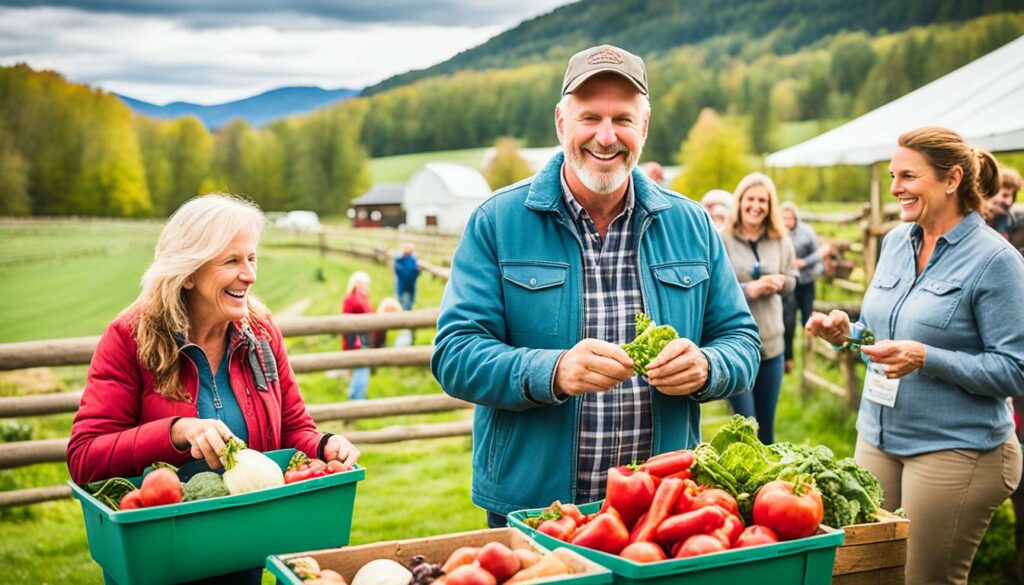
In late 2018, Forbes saw more bookings for outdoor and cultural tours. This trend could help farm tours succeed. You can highlight your farm’s unique parts, like caring for the land and animals or growing fruit, to attract visitors. Posts, videos, and stories can get visitors interested in these special activities.
Good visuals are vital for getting people interested in your farm tours. You don’t need to be a designer to make professional materials. Tools like Desygner can help. Photos and videos showing off the farm’s beauty, great food, and fun activities will grab people’s attention.
Use a mix of old and new marketing methods for the best results. Pair online ads and social media with local ads and community events. This mix tells a great story about your farm and appeals to a wide range of visitors.
Oahu has seen a rise in sustainable farming, improving the local food movement. Kahumana Organic Farms, started in 1978, plays a key role. This 31-acre farm is a leader in showing the benefits of organic farming. Aiding them is Kolea Farm on Oahu’s North Shore. Here, they run a special programme making fresh local food affordable.
Farms like Kahumana and Kolea offer tours that show exactly how organic farming works. They don’t just grow healthy crops. They also use renewable energy and save water. Visit these farms, and you’ll start to see why supporting sustainable farms matters. It helps local food grow and gives us great meals.
On these tours, you learn a lot about being green. They talk about permaculture and hold farming workshops. These methods are good for the planet because they protect the soil and lessen harmful gases. Plus, you can join in on the work to keep these farms eco-friendly.
As people learn more and want to know where their food comes from, the interest in these techniques grows. When they see how it all works, they often want to help and buy local. This helps our community be more about caring for the Earth.
To create an interesting farm tour, choose key places that show the farm’s heart. Make a safe, fun path for visitors. Be sure facilities like toilets and parking are good enough for the visitors.
Agritourism is when farms attract visitors through activities like fruit picking, staying on the farm, or special events. It gives people a real taste of farm life.
Agritourism helps farmers earn more, teaches people about farming, and ties the farm to the local community. Visitors have fun, learn new things, and appreciate where their food comes from.
Show places like gardens, orchards, and where animals live. Also, share how you use cool farming methods. This will grab visitors’ attention and teach them something new.
To keep visitors safe, don’t let them near dangerous machines, chemicals, or animals. Make sure the tour areas are safe and easy to see.
Safety steps mean visitors won’t get hurt and can enjoy family-friendly tours worry-free. This makes the visit fun and a great learning experience.
Think about any risks and set up safety rules. You can still have fun, hands-on activities that teach without putting visitors in danger.
Make sure you have enough toilets for visitors or offer portable ones. Parking needs to be easy, clear, and sheltered from the weather. Think about bigger groups and buses too.
Themed tours focus on special parts of the farm like how you care for orchards or use green energy. They’re great for people wanting to learn more and enjoy the visit fully.
Good signs and maps are key for safe, enjoyable self-guided visits. Adding fun things like scavenger hunts can make the tour more exciting and make sure visitors don’t miss anything interesting.
Make activities that fit the students’ ages and are hands-on and educational. Talk to teachers to make sure your activities meet their learning objectives and schedule plan.
Think about costs like salaries and upkeep, alongside with how much you’re spending on advertising. Run the numbers to find a price that covers your expenses but is still fair for visitors and profitable for the farm.
Use a good booking system, like Eventbrite, that handles reservations well. Have clear rules on group sizes, deposits, and cancellations to make everything run smoothly.
Get your team ready to be helpful, friendly, and full of energy. Make the visit memorable with sights, sounds, and chances for great photos to make people happy they came.
Make sure you have up-to-date insurance, clear signs, and follow the law. Have safety rules and watch over activities to keep visitors and your business safe.
Use social media to share interesting photos and stories about the farm. Tools like Desygner can help you make eye-catching adverts to get more visitors excited about the farm.
Show off your eco-friendly farming methods like organic crops and saving water. This teaches and inspires visitors to support farming that’s good for the planet.